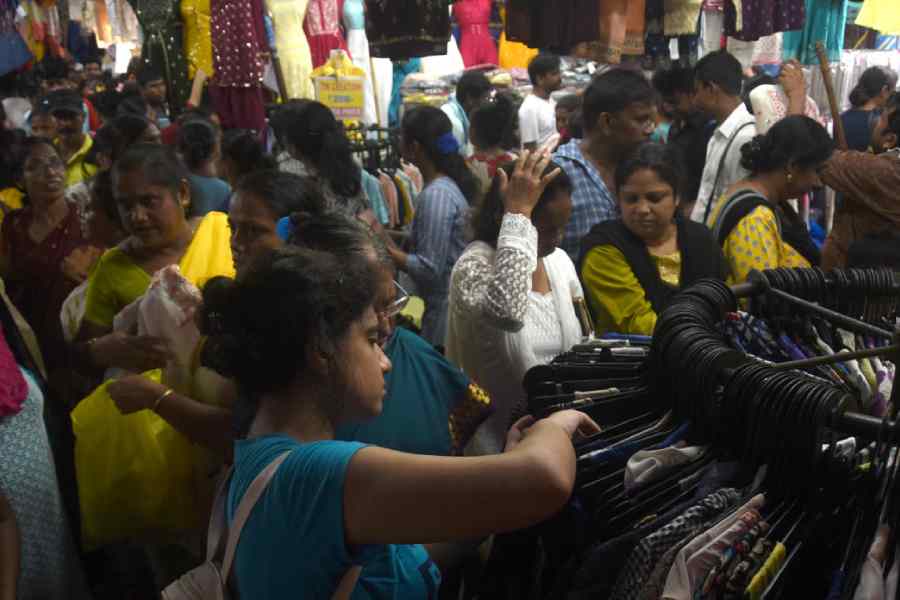Shop wiser
Sir — With just about a month to go for Durga Puja, Calcuttans are busy shopping. But shopping lists for women this year are a little longer. Besides outfits and matching accessories, many women are also buying pepper sprays and tasers to protect themselves while pandal hopping. This is prudent as incidents of harassment rise during the Pujas. While a taser or a pepper spray can save women from physical assault, how does one insulate oneself from the catcalling and the blowing of foghorns that men adopt as a means of expressing interest or communicating appreciation? Young people meeting and falling in love at pandals is a part of Durga Puja. Perhaps men should add a manual on consent to their shopping list so that this ritual is not corrupted.
Rambani Chatterjee, Calcutta
Dip in numbers
Sir — According to data from the National Statistical Office, the first official gauge of the economy’s performance so far in 2024-25, India’s real gross domestic product growth was at 6.7% between April and June. This is a five-quarter low and below the central bank’s projection. The actual number is underwhelming and marks a clear cooling in the economic momentum from last year’s GDP growth surge of 8.2%. At the onset of this fiscal year, the country hinged its hopes on a normal monsoon boosting farm sector output and easing inflation, which could lift the weak rural demand and private consumption witnessed last year. But this is yet to happen. What is worse, the long-drawn-out general election sharply scuppered public capex and the government will need to redouble its efforts to meet spending goals.
Gopalaswamy J., Chennai
Sir — Although the monsoon has been better than last year, it has been erratic and uneven, temporally as well as spatially. Projections of above-normal downpours in September may well affect standing kharif crops. This is a key monitorable for the Reserve Bank of India whose monetary policy panel members have flagged a 1% GDP growth loss this year and the next if interest rate cuts are delayed. The latest report of lower-than-expected GDP growth in the last quarter is thus worrying. This figure may dip lower and food inflation rise further as a result of seasonal vagaries.
Jakir Hussain, Kanpur
Riverine fury
Sir — Rivers reclaiming their old floodplains is a matter that deserves attention as well as a technical audit (“Memory of water”, Aug 1). The geological substrata of the embankments and heavy silting also contribute to rivers changing their courses. Recently, substrata overflooding resulted in buildings in Uttarakhand’s Joshimath developing cracks. The geological movement of subsoil is vital for tectonic shifts. Invisible underground retention of water is usually responsible for geological superstructures like mountains and rivers exhibiting external changes.
Indians worship rivers like mother-figures and occurrences like floods are explained away as mythical rage. Detailed scientific study is required to find out the real reason behind riverine activity. The article by Uddalak Mukherjee analysed some such activities in detail.
Sachidananda Satpathy, Sambalpur
Sir — At a time when mindless industrialisation and urbanisation rule the world, rivers are facing rare environmental challenges. Most river basins either run well below their capacity owing to excessive heat or overflow and reclaim old floodplains when it rains, as was the case with the Yamuna in Delhi and the Chaliyar in Wayanad. Reviving India’s rivers requires a comprehensive approach, including desilting, clearing of floodplains, habitat restoration, waste management and so on. Further, community mobilisation is key to bolstering government schemes and ensuring that elected representatives are held accountable to restore our rivers to their former glory.
Fateh Najamuddin, Lucknow
Sir — The two articles, “Memory of water” and “This is Teesta talking” (Sept 1), highlighted the plight of India’s rivers vividly. Indians may consider rivers to be sacred entities, but they are treated with indifference. We are killing our rivers by building dams in the most unimaginative manner. The rivers, in turn, are paying us back in our own coin by wreaking havoc along their path.
Amit Brahmo, Calcutta
Sir — An earthquake around 2,500 years ago could have caused the Ganges to abruptly change its course, according to a new study. Given the scary argument presented in “Memory of water”, one wonders what will happen should the Ganges ever reclaim its old course. About 140 million people could be affected if such an incident were ever to take place. In this context, it is not just crucial to rehabilitate India’s river but also to prepare for seismic shocks — most of India comprises a young and shifting plate and earthquakes will become common in the future. An earthquake can change the course of a river in an instant.
As with any civilisation, all of India’s rivers are cradles for cities and villages. Detailed geological mapping should be undertaken to see which areas are vulnerable to riverine shifts and the resultant loss of life and livelihood as it happened in Kerala recently.
A.K. Sen, Calcutta
Reign ends
Sir — After 2002, this would be the first time that the big three of tennis, Roger Federer, Rafael Nadal and Novak Djokovic, would be missing at the finals of the US Open (“The Serb & volley of questions”, Sept 1). For over two decades, the trio has ruled the tennis court with power, grace and elegance. The Olympic gold might have been the final feather in Djokovic’s cap. Given his age, his injuries will take time to heal. Their glorious reign will remain historic.
Anthony Henriques, Mumbai










